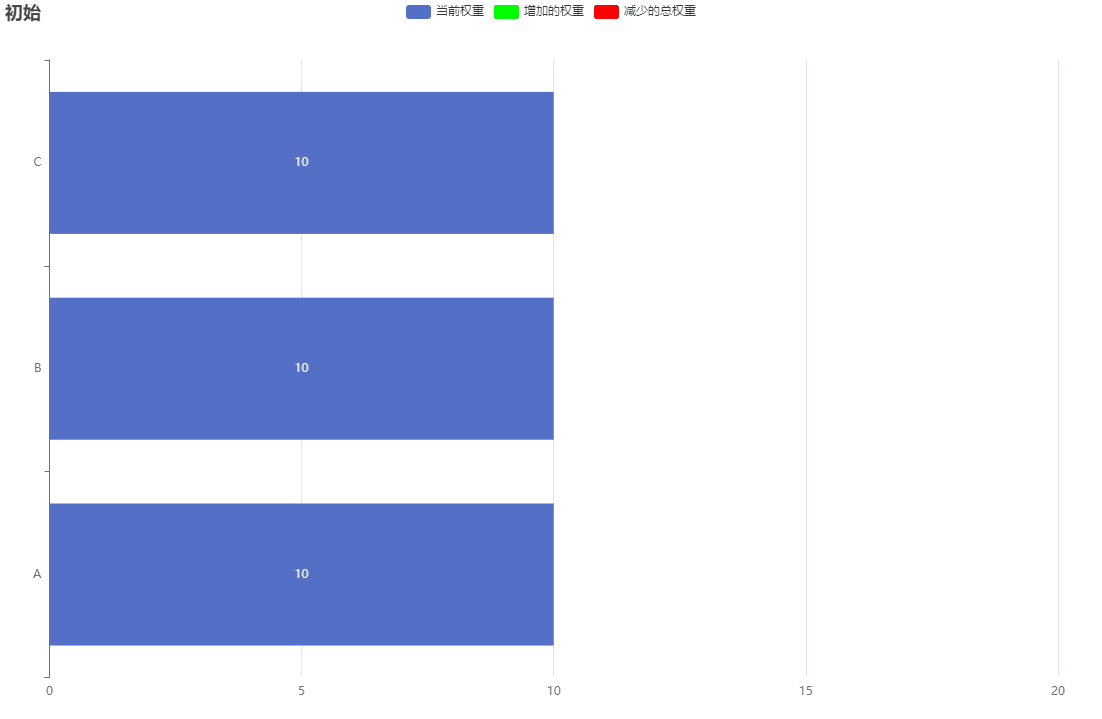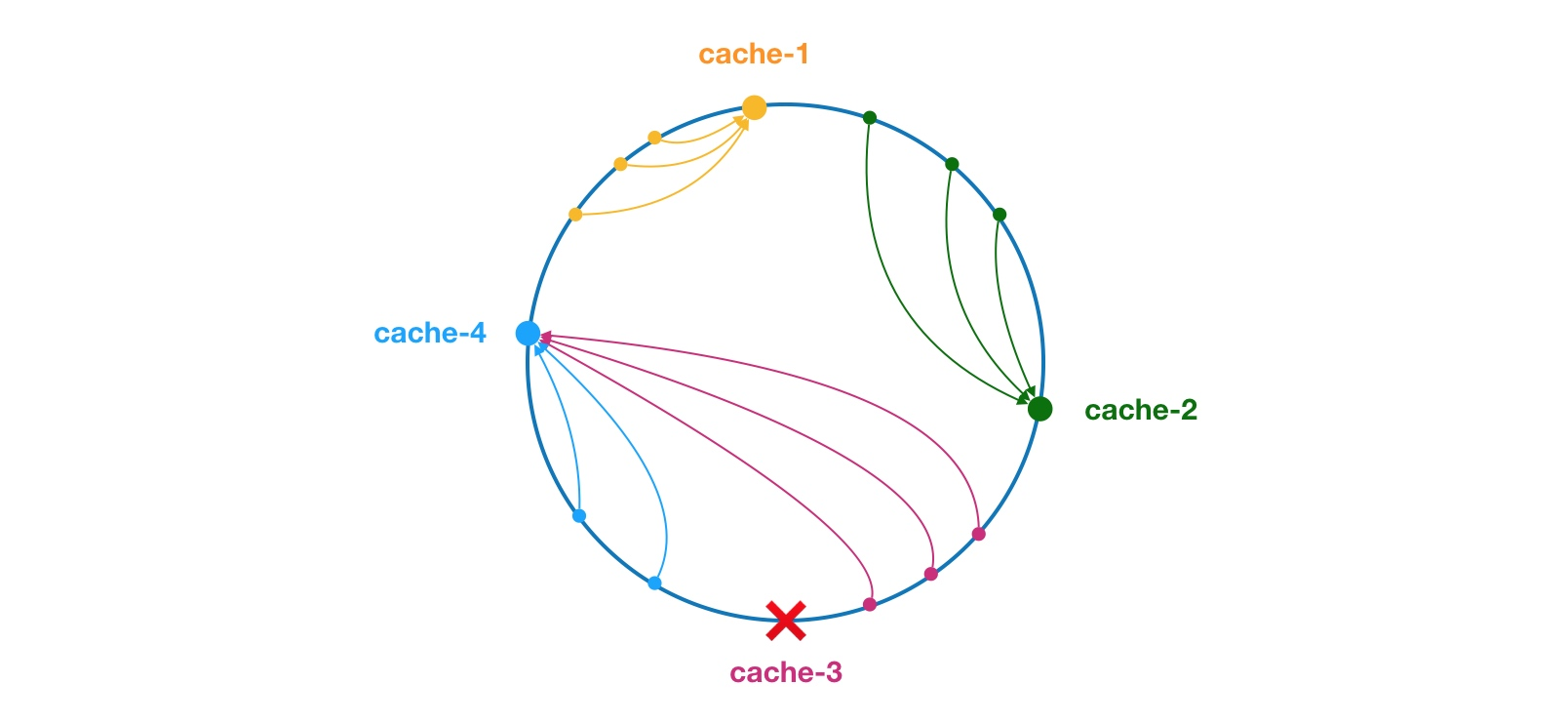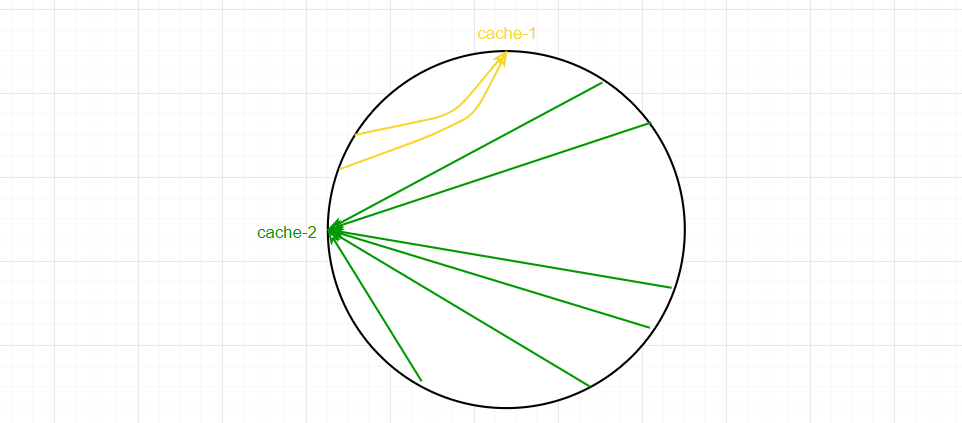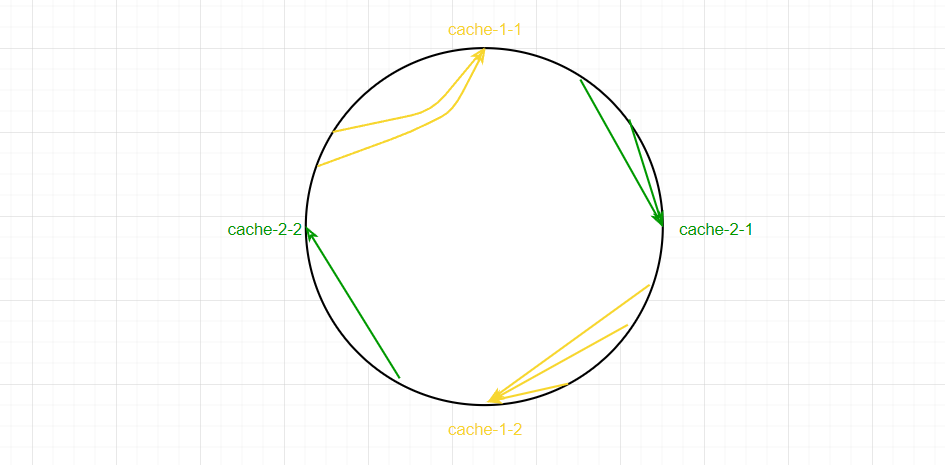前言
本文基于Dubbo2.6.x版本,中文注释版源码已上传github:xiaoguyu/dubbo
负载均衡,英文名称为Load Balance,其含义就是指将负载(工作任务)进行平衡、分摊到多个操作单元上进行运行。
例如:在Dubbo中,同一个服务有多个服务提供者,每个服务提供者所在的机器性能不一致。如果流量均匀分摊,则会导致有些服务提供者负载过高,有些则轻轻松松,导致资源浪费。负载均衡就解决这个问题。
源码
LoadBalance就是负载均衡的接口,咱们先看看类图

Dubbo提供了4中内置的负载均衡实现:
- RandomLoadBalance:基于权重随机算法
- LeastActiveLoadBalance:基于最少活跃调用数算法
- ConsistentHashLoadBalance:基于 hash 一致性算法
- RoundRobinLoadBalance:基于加权轮询算法
那么负载均衡是在哪里被用的的呢?
AbstractClusterInvoker的select和reselect方法。不熟悉这两个方法的,可以去看《Dubbo集群》
AbstractLoadBalance
抽象类封装了一些公共的逻辑,在看具体实现类之前,我们先看看抽象类AbstractLoadBalance中的方法
public <T> Invoker<T> select(List<Invoker<T>> invokers, URL url, Invocation invocation) {
if (invokers == null || invokers.isEmpty())
return null;
// 如果 invokers 列表中仅有一个 Invoker,直接返回即可,无需进行负载均衡
if (invokers.size() == 1)
return invokers.get(0);
// 调用 doSelect 方法进行负载均衡,该方法为抽象方法,由子类实现
return doSelect(invokers, url, invocation);
}
LoadBalance接口只有一个方法,那就是 select 方法,这是负载均衡的入口。根据 invoker 数量判断是否需要进行负载均衡。这里的 doSelect 是个抽象方法,由子类实现。
protected int getWeight(Invoker<?> invoker, Invocation invocation) {
int weight = invoker.getUrl().getMethodParameter(invocation.getMethodName(), Constants.WEIGHT_KEY, Constants.DEFAULT_WEIGHT);
if (weight > 0) {
// 获取服务提供者启动时间戳
long timestamp = invoker.getUrl().getParameter(Constants.REMOTE_TIMESTAMP_KEY, 0L);
if (timestamp > 0L) {
// 计算服务提供者运行时长
int uptime = (int) (System.currentTimeMillis() - timestamp);
// 获取服务预热时间,默认为10分钟
int warmup = invoker.getUrl().getParameter(Constants.WARMUP_KEY, Constants.DEFAULT_WARMUP);
// 如果服务运行时间小于预热时间,则重新计算服务权重,即降权
if (uptime > 0 && uptime < warmup) {
// 重新计算服务权重
weight = calculateWarmupWeight(uptime, warmup, weight);
}
}
}
return weight;
}
static int calculateWarmupWeight(int uptime, int warmup, int weight) {
// 计算权重,下面代码逻辑上形似于 (uptime / warmup) * weight。
// 随着服务运行时间 uptime 增大,权重计算值 ww 会慢慢接近配置值 weight
int ww = (int) ((float) uptime / ((float) warmup / (float) weight));
return ww < 1 ? 1 : (ww > weight ? weight : ww);
}
getWeight 是获取权重的方法,默认权重为100,这里有个服务预热的操作,当服务的启动时间小于预热时间,权重会减少,这个权重由 calculateWarmupWeight 方法计算。
预热的目的是让服务启动后“低功率”运行一段时间,使其效率慢慢提升至最佳状态。
以上就是抽象类的全部方法。下面我们看实现类的。
RandomLoadBalance
RandomLoadBalance 是加权随机算法的具体实现,是Dubbo默认的负载均衡策略。
假设我们有一组服务器 servers = [A, B, C],他们对应的权重为 weights = [5, 3, 2],权重总和为10。

我们取一个大于等于0,小于10的随机数,计算随机数落在哪个区间。例如4在A区间,7在B区间。
权重越大,落在该区间的概率就越大。这就是加权随机算法。
下面看具体代码实现
public class RandomLoadBalance extends AbstractLoadBalance {
public static final String NAME = "random";
private final Random random = new Random();
@Override
protected <T> Invoker<T> doSelect(List<Invoker<T>> invokers, URL url, Invocation invocation) {
int length = invokers.size(); // Number of invokers
int totalWeight = 0; // The sum of weights
boolean sameWeight = true; // Every invoker has the same weight?
// 下面这个循环有两个作用,第一是计算总权重 totalWeight,
// 第二是检测每个服务提供者的权重是否相同
for (int i = 0; i < length; i++) {
int weight = getWeight(invokers.get(i), invocation);
totalWeight += weight; // Sum
// 检测当前服务提供者的权重与上一个服务提供者的权重是否相同,
// 不相同的话,则将 sameWeight 置为 false。
if (sameWeight && i > 0
&& weight != getWeight(invokers.get(i - 1), invocation)) {
sameWeight = false;
}
}
if (totalWeight > 0 && !sameWeight) {
// 随机获取一个 [0, totalWeight) 区间内的数字
int offset = random.nextInt(totalWeight);
// Return a invoker based on the random value.
// 循环让 offset 数减去服务提供者权重值,当 offset 小于0时,返回相应的 Invoker。
// 举例说明一下,我们有 servers = [A, B, C],weights = [5, 3, 2],offset = 7。
// 第一次循环,offset - 5 = 2 > 0,即 offset > 5,
// 表明其不会落在服务器 A 对应的区间上。
// 第二次循环,offset - 3 = -1 < 0,即 5 < offset < 8,
// 表明其会落在服务器 B 对应的区间上
for (int i = 0; i < length; i++) {
// 让随机值 offset 减去权重值
offset -= getWeight(invokers.get(i), invocation);
if (offset < 0) {
// 返回相应的 Invoker
return invokers.get(i);
}
}
}
// 如果所有服务提供者权重值相同,此时直接随机返回一个即可
return invokers.get(random.nextInt(length));
}
}
如果权重一致,就随机选择一个。如果权重不同,则根据权重分配。
LeastActiveLoadBalance
最小活跃数负载均衡。这个活跃数表示执行中的请求数量。每个服务提供者对应一个活跃数 active。初始情况下,所有服务提供者活跃数均为0。每收到一个请求,活跃数加1,完成请求后则将活跃数减1。
在流量均匀的情况下,活跃数越低的服务提供者,其性能越好。
protected <T> Invoker<T> doSelect(List<Invoker<T>> invokers, URL url, Invocation invocation) {
int length = invokers.size(); // Number of invokers
// 最小的活跃数
int leastActive = -1; // The least active value of all invokers
// 具有相同“最小活跃数”的服务者提供者(以下用 Invoker 代称)数量
int leastCount = 0; // The number of invokers having the same least active value (leastActive)
// leastIndexs 用于记录具有相同“最小活跃数”的 Invoker 在 invokers 列表中的下标信息
int[] leastIndexs = new int[length]; // The index of invokers having the same least active value (leastActive)
int totalWeight = 0; // The sum of with warmup weights
// 第一个最小活跃数的 Invoker 权重值,用于与其他具有相同最小活跃数的 Invoker 的权重进行对比,
// 以检测是否“所有具有相同最小活跃数的 Invoker 的权重”均相等
int firstWeight = 0; // Initial value, used for comparision
boolean sameWeight = true; // Every invoker has the same weight value?
// 遍历 invokers 列表
for (int i = 0; i < length; i++) {
Invoker<T> invoker = invokers.get(i);
// 获取 Invoker 对应的活跃数
int active = RpcStatus.getStatus(invoker.getUrl(), invocation.getMethodName()).getActive(); // Active number
// 获取权重
int afterWarmup = getWeight(invoker, invocation); // Weight
// 发现更小的活跃数,重新开始
if (leastActive == -1 || active < leastActive) { // Restart, when find a invoker having smaller least active value.
// 使用当前活跃数 active 更新最小活跃数 leastActive
leastActive = active; // Record the current least active value
// 更新 leastCount 为 1
leastCount = 1; // Reset leastCount, count again based on current leastCount
// 记录当前下标值到 leastIndexs 中
leastIndexs[0] = i; // Reset
totalWeight = afterWarmup; // Reset
firstWeight = afterWarmup; // Record the weight the first invoker
sameWeight = true; // Reset, every invoker has the same weight value?
// 当前 Invoker 的活跃数 active 与最小活跃数 leastActive 相同
} else if (active == leastActive) { // If current invoker's active value equals with leaseActive, then accumulating.
// 在 leastIndexs 中记录下当前 Invoker 在 invokers 集合中的下标
leastIndexs[leastCount++] = i; // Record index number of this invoker
// 累加权重
totalWeight += afterWarmup; // Add this invoker's weight to totalWeight.
// If every invoker has the same weight?
// 检测当前 Invoker 的权重与 firstWeight 是否相等,
// 不相等则将 sameWeight 置为 false
if (sameWeight && i > 0
&& afterWarmup != firstWeight) {
sameWeight = false;
}
}
}
// assert(leastCount > 0)
// 当只有一个 Invoker 具有最小活跃数,此时直接返回该 Invoker 即可
if (leastCount == 1) {
// If we got exactly one invoker having the least active value, return this invoker directly.
return invokers.get(leastIndexs[0]);
}
// 有多个 Invoker 具有相同的最小活跃数,但它们之间的权重不同
if (!sameWeight && totalWeight > 0) {
// If (not every invoker has the same weight & at least one invoker's weight>0), select randomly based on totalWeight.
// 随机生成一个 [0, totalWeight) 之间的数字
int offsetWeight = random.nextInt(totalWeight) + 1;
// Return a invoker based on the random value.
// 循环让随机数减去具有最小活跃数的 Invoker 的权重值,
// 当 offset 小于等于0时,返回相应的 Invoker
for (int i = 0; i < leastCount; i++) {
int leastIndex = leastIndexs[i];
// 获取权重值,并让随机数减去权重值
offsetWeight -= getWeight(invokers.get(leastIndex), invocation);
if (offsetWeight <= 0)
return invokers.get(leastIndex);
}
}
// If all invokers have the same weight value or totalWeight=0, return evenly.
// 如果权重相同或权重为0时,随机返回一个 Invoker
return invokers.get(leastIndexs[random.nextInt(leastCount)]);
}
代码比较多,不过都有注释,耐心看即可。这里大体做了几件事:
- 遍历 invokers 集合,找出活跃数最小的 invoker
- 如果只有一个 invoker 有最小活跃数,则返回
- 如果有多个 invoker 有相同的最小活跃数,则这些 invoker 进行加权随机算法处理(也就是对这几个最小活跃数 invoker 进行 RandomLoadBalance 的逻辑)
这里有个点想扩展说下,就是获取活跃数的方法
RpcStatus.getStatus(invoker.getUrl(), invocation.getMethodName()).getActive();
RpcStatus记录着当前调用次数、总数、失败数、调用间隔等状态信息。
这些信息,在服务消费者端由ActiveLimitFilter记录,在服务提供者端由ExecuteLimitFilter记录。也就是,想要拿到正确的活跃数,需要ActiveLimitFilter生效才行。
@Activate(group = Constants.CONSUMER, value = Constants.ACTIVES_KEY)
public class ActiveLimitFilter implements Filter
ActiveLimitFilter生效需要满足两个条件,消费者端以及URL中携带actives参数。actives可在消费者端或生产者端配置,含义为:每服务消费者每服务每方法最大并发调用数
<dubbo:service interface="com.alibaba.dubbo.demo.DemoService" ref="demoService" registry="remoteRegistry" actives="5" />
<dubbo:reference id="demoService" interface="com.alibaba.dubbo.demo.DemoService" loadbalance="leastactive" actives="5" />
当然,也能给消费者接口指定过滤器的方法来启用ActiveLimitFilter
<dubbo:reference id="demoService" interface="com.alibaba.dubbo.demo.DemoService" filter="activelimit" />
RoundRobinLoadBalance
RoundRobinLoadBalance是加权轮询负载均衡的实现。加权轮询的原理步骤如下:
假设服务 [A, B, C] 的权重为 [5, 1, 1] ,即总权重为 7, 当前权重currentWeight初始为[0, 0, 0]
- 当前权重加上每个服务各自的权重,跳转步骤2
此时currentWeight为 [0+5, 0+1, 0+1] = [5, 1, 1]
-
返回currentWeight中最高的服务,跳转步骤3
currentWeight为 [5, 1, 1] ,返回服务A
-
将第2步中的那个最高权重在currentWeight对应的值减去总权重,跳转步骤4
currentWeight为 [5 - 7, 1, 1] = [-2, 1, 1]
-
重复步骤1
下面的GIF图为了好表示柱状图,所以我将currentWeight初始权重变为10

经过一定循环次数,最终currentWeight又会回归初始值。而这个循环次数计算如下:
次数 = 服务A的权重 + 服务B的权重 + …
每个服务的调用次数也等于它的权重
看完原理,我们继续看源码
protected <T> Invoker<T> doSelect(List<Invoker<T>> invokers, URL url, Invocation invocation) {
// key = 全限定类名 + "." + 方法名,比如 com.xxx.DemoService.sayHello
String key = invokers.get(0).getUrl().getServiceKey() + "." + invocation.getMethodName();
// 获取 url 到 WeightedRoundRobin 映射表,如果为空,则创建一个新的
ConcurrentMap<String, WeightedRoundRobin> map = methodWeightMap.get(key);
if (map == null) {
methodWeightMap.putIfAbsent(key, new ConcurrentHashMap<String, WeightedRoundRobin>());
map = methodWeightMap.get(key);
}
// 权重总和
int totalWeight = 0;
// 最大权重
long maxCurrent = Long.MIN_VALUE;
long now = System.currentTimeMillis();
Invoker<T> selectedInvoker = null;
WeightedRoundRobin selectedWRR = null;
// 下面这个循环主要做了这样几件事情:
// 1. 遍历 Invoker 列表,检测当前 Invoker 是否有
// 相应的 WeightedRoundRobin,没有则创建
// 2. 检测 Invoker 权重是否发生了变化,若变化了,
// 则更新 WeightedRoundRobin 的 weight 字段
// 3. 让 current 字段加上自身权重,等价于 current += weight
// 4. 设置 lastUpdate 字段,即 lastUpdate = now
// 5. 寻找具有最大 current 的 Invoker,以及 Invoker 对应的 WeightedRoundRobin,
// 暂存起来,留作后用
// 6. 计算权重总和
for (Invoker<T> invoker : invokers) {
String identifyString = invoker.getUrl().toIdentityString();
WeightedRoundRobin weightedRoundRobin = map.get(identifyString);
int weight = getWeight(invoker, invocation);
if (weight < 0) {
weight = 0;
}
// 检测当前 Invoker 是否有对应的 WeightedRoundRobin,没有则创建
if (weightedRoundRobin == null) {
weightedRoundRobin = new WeightedRoundRobin();
// 设置 Invoker 权重
weightedRoundRobin.setWeight(weight);
// 存储 url 唯一标识 identifyString 到 weightedRoundRobin 的映射关系
map.putIfAbsent(identifyString, weightedRoundRobin);
weightedRoundRobin = map.get(identifyString);
}
// Invoker 权重不等于 WeightedRoundRobin 中保存的权重,说明权重变化了,此时进行更新
if (weight != weightedRoundRobin.getWeight()) {
//weight changed
weightedRoundRobin.setWeight(weight);
}
// 让 current 加上自身权重,等价于 current += weight
long cur = weightedRoundRobin.increaseCurrent();
// 设置 lastUpdate,表示近期更新过
weightedRoundRobin.setLastUpdate(now);
if (cur > maxCurrent) {
maxCurrent = cur;
// 将具有最大 current 权重的 Invoker 赋值给 selectedInvoker
selectedInvoker = invoker;
// 将 Invoker 对应的 weightedRoundRobin 赋值给 selectedWRR,留作后用
selectedWRR = weightedRoundRobin;
}
// 计算权重总和
totalWeight += weight;
}
// 对 <identifyString, WeightedRoundRobin> 进行检查,过滤掉长时间未被更新的节点。
// 该节点可能挂了,invokers 中不包含该节点,所以该节点的 lastUpdate 长时间无法被更新。
// 若未更新时长超过阈值后,就会被移除掉,默认阈值为60秒。
if (!updateLock.get() && invokers.size() != map.size()) {
if (updateLock.compareAndSet(false, true)) {
try {
// copy -> modify -> update reference
ConcurrentMap<String, WeightedRoundRobin> newMap = new ConcurrentHashMap<String, WeightedRoundRobin>();
// 拷贝
newMap.putAll(map);
// 遍历修改,即移除过期记录
Iterator<Entry<String, WeightedRoundRobin>> it = newMap.entrySet().iterator();
while (it.hasNext()) {
Entry<String, WeightedRoundRobin> item = it.next();
if (now - item.getValue().getLastUpdate() > RECYCLE_PERIOD) {
it.remove();
}
}
// 更新引用
methodWeightMap.put(key, newMap);
} finally {
updateLock.set(false);
}
}
}
if (selectedInvoker != null) {
// 让 current 减去权重总和,等价于 current -= totalWeight
selectedWRR.sel(totalWeight);
// 返回具有最大 current 的 Invoker
return selectedInvoker;
}
// should not happen here
return invokers.get(0);
}
注释写的很详细了,和原理步骤差不多,源码中多个对长时间未更新 invoker 的处理。
ConsistentHashLoadBalance
一致性Hash算法。
其原理简单讲,就是假定有一个圆环,每个服务根据其 hash 值,在圆环上有个位置(如图的cache-1、cache-2等)。当有请求过来的,同样根据请求的 hash 值确定请求的位置,并根据请求的位置去获取最近的下一个服务的位置。如下图:

当请求落在 cache-2 和 cache-3 之间时,下一个最近的是 cache-3,如果 cache-3 服务不可用,那么最近的下个服务就是 cache-4
这时,又引入了一个资源倾斜的问题,那就是大量请求集中在同一个服务中。由于服务在圆环上分布不均,导致大部分请求都落在cache-2中,如下图:

那么该如何处理资源倾斜的问题?引入虚拟节点,就是一个服务有多个多个位置,这样就能使请求更均匀,如下图:

以上就是一致性hash算法的原理。下面讲讲Dubbo的源码
public class ConsistentHashLoadBalance extends AbstractLoadBalance {
private final ConcurrentMap<String, ConsistentHashSelector<?>> selectors = new ConcurrentHashMap<String, ConsistentHashSelector<?>>();
@Override
protected <T> Invoker<T> doSelect(List<Invoker<T>> invokers, URL url, Invocation invocation) {
String methodName = RpcUtils.getMethodName(invocation);
String key = invokers.get(0).getUrl().getServiceKey() + "." + methodName;
// 获取 invokers 原始的 hashcode
int identityHashCode = System.identityHashCode(invokers);
ConsistentHashSelector<T> selector = (ConsistentHashSelector<T>) selectors.get(key);
// 如果 invokers 是一个新的 List 对象,意味着服务提供者数量发生了变化,可能新增也可能减少了。
// 此时 selector.identityHashCode != identityHashCode 条件成立
if (selector == null || selector.identityHashCode != identityHashCode) {
// 创建新的 ConsistentHashSelector
selectors.put(key, new ConsistentHashSelector<T>(invokers, methodName, identityHashCode));
selector = (ConsistentHashSelector<T>) selectors.get(key);
}
// 调用 ConsistentHashSelector 的 select 方法选择 Invoker
return selector.select(invocation);
}
private static final class ConsistentHashSelector<T> {...}
}
doSelect 方法先从缓存获取 selector ,如果缓存没有,则创建并放入缓存。然后调用 selector.select 方法获取 invoker 。所以一致性 hash 的实现,在ConsistentHashSelector中。我们先看其构造方法
ConsistentHashSelector(List<Invoker<T>> invokers, String methodName, int identityHashCode) {
// 可以认为virtualInvokers组成了hash环
this.virtualInvokers = new TreeMap<Long, Invoker<T>>();
this.identityHashCode = identityHashCode;
URL url = invokers.get(0).getUrl();
// 获取虚拟节点数,默认为160
this.replicaNumber = url.getMethodParameter(methodName, "hash.nodes", 160);
// 获取参与 hash 计算的参数下标值,默认对第一个参数进行 hash 运算
String[] index = Constants.COMMA_SPLIT_PATTERN.split(url.getMethodParameter(methodName, "hash.arguments", "0"));
argumentIndex = new int[index.length];
for (int i = 0; i < index.length; i++) {
argumentIndex[i] = Integer.parseInt(index[i]);
}
for (Invoker<T> invoker : invokers) {
String address = invoker.getUrl().getAddress();
for (int i = 0; i < replicaNumber / 4; i++) {
// 对 address + i 进行 md5 运算,得到一个长度为16的字节数组
byte[] digest = md5(address + i);
// 对 digest 部分字节进行4次 hash 运算,得到四个不同的 long 型正整数
for (int h = 0; h < 4; h++) {
// h = 0 时,取 digest 中下标为 0 ~ 3 的4个字节进行位运算
// h = 1 时,取 digest 中下标为 4 ~ 7 的4个字节进行位运算
// h = 2, h = 3 时过程同上
long m = hash(digest, h);
// 将 hash 到 invoker 的映射关系存储到 virtualInvokers 中,
// virtualInvokers 需要提供高效的查询操作,因此选用 TreeMap 作为存储结构
virtualInvokers.put(m, invoker);
}
}
}
}
ConsistentHashSelector的构造方法,主要是计算 invokers 的每一个 invoker 的hash,并将其放入 virtualInvokers 中。从这里可以看到,Dubbo默认的虚拟节点为160个。对比一致性 hash 算法中,virtualInvokers 就是 hash 环,invoker 就是节点。
我们继续看如何从 hash 环中找到最近的节点
public Invoker<T> select(Invocation invocation) {
// 将参数转为 key
String key = toKey(invocation.getArguments());
// 对参数 key 进行 md5 运算
byte[] digest = md5(key);
// 取 digest 数组的前四个字节进行 hash 运算,再将 hash 值传给 selectForKey 方法,
// 寻找合适的 Invoker
return selectForKey(hash(digest, 0));
}
private Invoker<T> selectForKey(long hash) {
// 到 TreeMap 中查找第一个节点值大于或等于当前 hash 的 Invoker
Map.Entry<Long, Invoker<T>> entry = virtualInvokers.tailMap(hash, true).firstEntry();
// 如果 hash 大于 Invoker 在圆环上最大的位置,此时 entry = null,
// 需要将 TreeMap 的头节点赋值给 entry
if (entry == null) {
entry = virtualInvokers.firstEntry();
}
return entry.getValue();
}
选择的过程也很简单,依赖的是 TreeMap 的 tailMap 方法。
总结
本文介绍了Dubbo内置的4中负载均衡实现。至此,Dubbo的集群容错的四个部分,也就是服务目录 Directory、服务路由 Router、集群 Cluster 和负载均衡 LoadBalance 都已全部讲完。
参考资料
文章评论